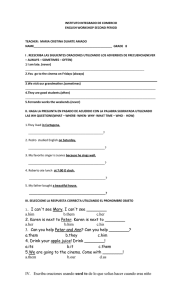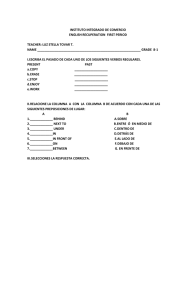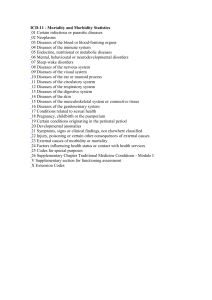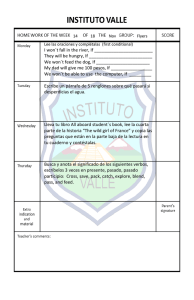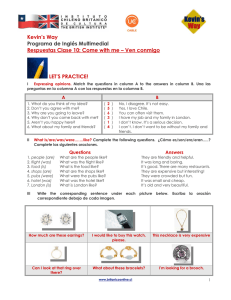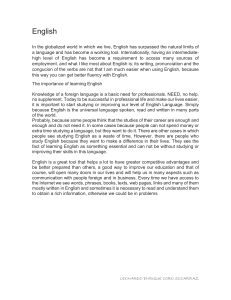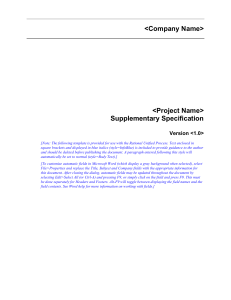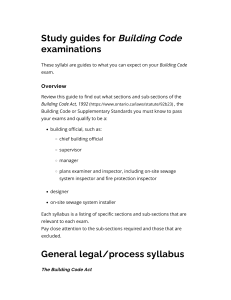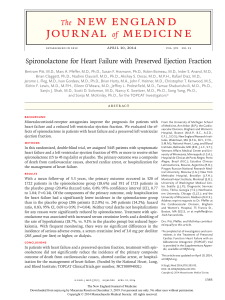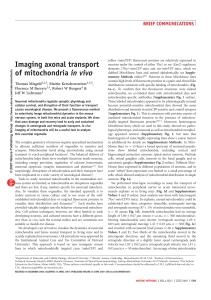BPM Additional Practice-Self Evaluation
Anuncio
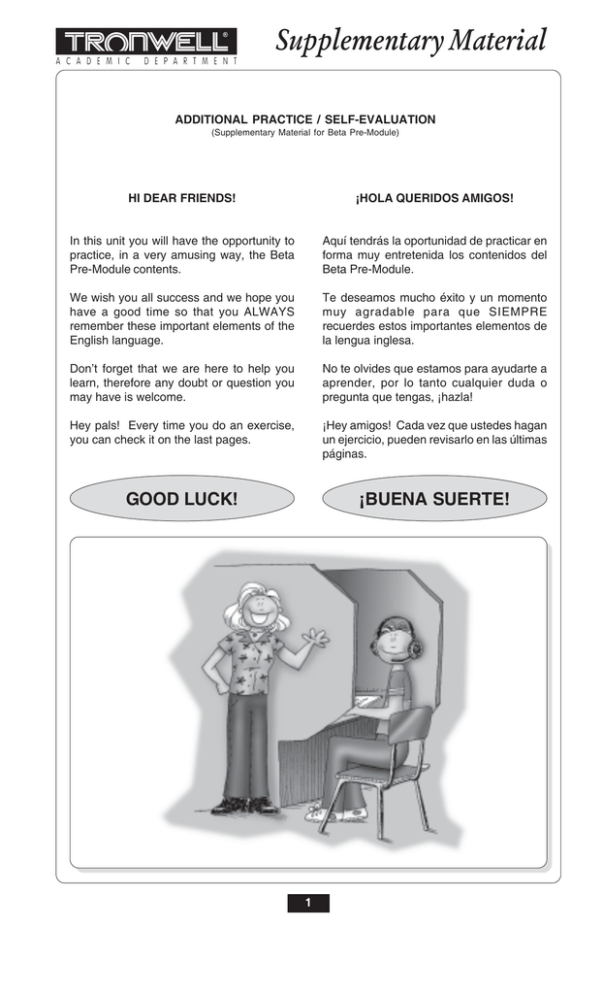
Supplementary Material ADDITIONAL PRACTICE / SELF-EVALUATION (Supplementary Material for Beta Pre-Module) HI DEAR FRIENDS! ¡HOLA QUERIDOS AMIGOS! In this unit you will have the opportunity to practice, in a very amusing way, the Beta Pre-Module contents. Aquí tendrás la oportunidad de practicar en forma muy entretenida los contenidos del Beta Pre-Module. We wish you all success and we hope you have a good time so that you ALWAYS remember these important elements of the English language. Te deseamos mucho éxito y un momento muy agradable para que SIEMPRE recuerdes estos importantes elementos de la lengua inglesa. Don’t forget that we are here to help you learn, therefore any doubt or question you may have is welcome. No te olvides que estamos para ayudarte a aprender, por lo tanto cualquier duda o pregunta que tengas, ¡hazla! Hey pals! Every time you do an exercise, you can check it on the last pages. ¡Hey amigos! Cada vez que ustedes hagan un ejercicio, pueden revisarlo en las últimas páginas. GOOD LUCK! ¡BUENA SUERTE! 1 Supplementary Material I. Complete the sentences below using the verb in parenthesis. Use the picture as a hint to understand the text. I. Complete las oraciones a continuación utilizando los verbos en paréntesis. Use los dibujos para comprender el significado del texto. Example: John is buying tickets for the cinema. (buy) 1. The women are _________________________ the windows. (close) 2. He is _________________________ the newspaper. (read) 3. The man is _________________________a taxi. (drive) 4. Amy is _________________________ a letter. (write) 5. The secretary is _________________________ the telephone. (answer) 6. She is _________________________ an envelope. (open) 7. The children are _________________________ in the living room. (sit) 8. I am _________________________ my lesson. (study) 2 Supplementary Material II. II. Complete these sentences using “am, “is”, or “are”. 1. 2. 3. 4. 5. 6. 7. 8. 9. 10. 11. Complete estas oraciones usando “am, “is”, or “are”. The students ______________ studying English. I ______________ sitting on a chair. Paul and Mary ______________ smoking cigarettes. The boy ______________ selling newspapers. The pilots ______________ flying helicopters. I ______________ typing a letter. He ______________ answering the telephone. We ______________ eating hamburgers. The men ______________ drinking beer in a pub. The people ______________ dancing rock-and-roll. The man ______________ driving a jeep. III. Match the following groups of words with their corresponding pictures. Then, write the sentences in the correct order. III. Relacione los siguientes grupos de palabras con su correspondiente imagen. Luego, escriba las oraciones en correcto orden. 1. Mary - looking - is - picture - at - the ___________________________________________ 2. soft drinks - are - women - the - drinking ___________________________________________ 3. to - we - listening - music - are ___________________________________________ 4. umbrella- is - Paul - carrying - an - ? ___________________________________________ 5. is - magazine - she - not - reading - a ___________________________________________ 6. cigarettes - smoking - they - are ___________________________________________ 7. your - is - what - name -? ___________________________________________ 3 Supplementary Material IV. Complete this paragraph using “am”, “is”, or “are” and the following verbs in the word bank below: IV. Complete este párrafo utilizando “am”, “is” o “are” y los siguientes verbos en el recuadro de abajo: I (1) _________ (2) __________ at Tronwell. It (3) ________ an English institute. At this moment, I (4) ______ (5) ___________ module one. I (6) ______ (7) __________ at the people in the laboratory. A student (8) ______ (9) ___________ to a tape, a man (10) ______ (11)___________ questions to the teachers. Two men (12)______ (13) ___________ in the lab. reading, studying, writing, asking, looking, listening, talking, walking 4 Supplementary Material V. Write sentences according to the pictures and the example: V. Escriba la oración correspondiente a cada ilustración, como el ejemplo: Example: She is washing the dishes. 1. ______________________________ . 2. ______________________________ . 3. ______________________________ . 4. ______________________________ . 5. ______________________________ . 6. ______________________________ . 5 Supplementary Material VI. Complete the following dialogs: VI. Complete los siguientes diálogos: 1. A: Is _________________ (a) sitting _______________ (b) an armchair? B: No, she is sitting on a ___________ (c). 2. A: ___________ (d) Paul ___________ (e) English? B: No, he isn’t. ___________ (f) ___________ (g) reading a ___________ (h). 3. A: What ___________ (i) Mark eating? B: He is ___________ (j) a ___________ (k). 4. A: What ___________ (l) the girl carrying? B: ________ (m) is carrying __________ (n) umbrella . 5. A: What is ___________ (o) doing? B: He __________ (p) listening __________ (q) music . 6 Supplementary Material VII. Answer these questions using the negative short answer. Follow the example: VII. Conteste las siguientes preguntas utilizando respuestas cortas, como el ejemplo: Example: Is he smoking a cigar? No, he isn’t. 1. Is she watching a T.V. program? No, _________ . 2. Are they playing rugby? No, _________ . 3. Is he flying a helicopter? No, _________ . 4. Is he carrying a package? No, _________ . 5. Are we reading a novel? No, _________ . 6. Are you opening a window? No, _________ . VIII. Change the following sentences into negative: VIII. Transforme las siguiente oraciones a la forma negativa: 1. Catherine is watching TV. ___________________________________________ 2. The girl is riding on a motorcycle. ___________________________________________ 3. They are carrying chairs. ___________________________________________ 4. The teacher is answering questions. ___________________________________________ 7 Supplementary Material IX. Answer these questions using short answers according to the given hints. Follow the examples: IX. Responda las siguientes preguntas utilizando respuestas cortas de acuerdo a las pistas dadas, como en el ejemplo: Example: Are the students listening to a lab session? Yes, they are. Is Judy dancing in a discotheque? No, she isn’t. 1. Is the secretary typing a letter? Yes, _________________________________________ 2. Is the man answering the phone? No, _________________________________________ 3. Are the men working in a hospital? No, _________________________________________ 4. Is the girl listening to the radio? No, _________________________________________ 5. Are the cups on the table? Yes, _________________________________________ 6. Are you buying tickets for the cinema? Yes, _________________________________________ 8 Supplementary Material KEY CHECK I. II. III. 1. closing 2. reading 3. driving 4. writing 5. answering 6. opening 7. sitting 8. studying 1. are 2. am 3. are 4. is 5. are 7. is 8. are 9. are 10. are 11. is 6. am 1. Mary is looking at the picture. 2. The women are drinking soft drinks. 3. We are listening to music. 4. Is Paul carrying an umbrella? 5. She is not reading a magazine. 6. They are smoking cigarettes. 7. What is your name? IV. (1) am (2) studying (3) is (4) am (5) studying / reading (6) am (7) looking (8) is (9) listening (11) asking (12) are (10) is (13) talking / walking / reading / studying / writing V. 1. She is opening / closing a door. 2. He is flying a helicopter. / The helicopter is flying. 3. He is smoking a cigarette. / reading / drinking coffee. 4. She is eating an apple. 5. She is writing a letter. 6. He is riding on a motorcycle. 9 Supplementary Material VI. 1. A: (a) she B: (c) chair (b) in 2. A: (d) is B: (f) he (e) studying? (g) is 3. A: (i) B: (j) (k) hamburger is eating 4. A: (l) is B: (m) she (n) an 5. A: (o) he B: (p) is (q) to VII. 1. No, she isn’t. (h) newspaper 4. No, he isn’t. 2. No, they aren’t. 5. No, you aren’t./ No, we aren’t. 3. No, he isn’t. 6. No, I’m not VIII. 1. Catherine isn’t watching TV. 2. The girl isn’t riding on a motorcycle. 3. They aren’t carrying chairs. 4. The teacher isn’t answering questions. IX. 1. Yes, she is. 4. No, she isn’t. 2. No, he isn’t. 5. Yes, they are. 3. No, they aren’t. 6. Yes, I am / Yes, we are. 10
